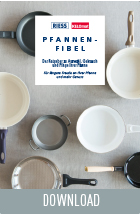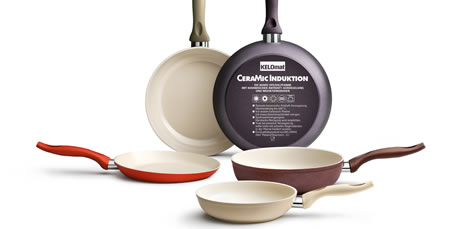GUIDANCE CARE & USE
Pans
General rules
for many years of enjoyment from using your pan
– 1) Avoid overheating the pan.
If you use moderate heat, aroma and taste have more opportunity to develop. So your food will be more enjoyable and your pan will last longer!
The right way to use your pan:
- NEVER heat the pan when it is empty.
- Select the cooker ring with the correct diameter for the pot and never use a ring which is too small. Please also follow your cooker or hob instructions.
- Distribute the oil or fat evenly over the base of the pan and heat in stages. NEVER start at the highest setting. Heat thin-based pans particularly slowly and carefully.
- The correct temperature has been reached with the fat or oil shows ripples as it moves around the pan.
- Turn down the temperature immediately if the oil begins to steam or smoke. Depending on the type of oil used, the optimum temperature should be around 200 °C.
- When cooking on induction hobs, please check that your pan is suitable for induction. If so, never use the boost function, as this is intended for rapid heating of large quantities of liquid and not for frying.
– 2) Always watch the pan when frying food.
- Oil can catch fire.*)
- The pan can overheat.
- The food can burn.
*) Caution: if the oil catches fire, never try to extinguish with water. Close the pan with the lid in order to cut off the supply of oxygen.
– 3) Clean your pan in the right way.
You can wash the pan in the dishwasher – but this shortens the life of the non-stick coating. Washing by hand helps to protect the pan.
- Remove food residues with a paper towel.
- Remove any remaining residues with a soft sponge or cloth and mild detergents. Avoid abrasive scrubbers and cleaners, steel wool, hard brushes etc. and also aggressive and abrasive cleaning agents and detergents.
- If crusts form that are hard to remove, soak for some time in water and detergent. If material has burnt on hard, bring briefly to the boil.
– 4) Store carefully
Dry carefully, then hang up or stack. If pans are stacked, lay kitchen paper or pan protectors between the individual pans in order to avoid scratching.
MORE TIPS FOR PANS DEPENDING ON MATERIAL
PANS WITH SPECIAL COATING

– Before using pans, and after cleaning (particularly when using the dishwasher), rub round pan lightly with kitchen paper soaked in a little oil.
– We recommend hand washing to prolong the life of the coating.
– Use special kitchen utensils of soft materials to stir and turn food in the pan. Never cut food in the pan using a knife or use pointed or metal utensils. These can damage the coating and the non-stick characteristics are lost.
– The pan may not be heated above 260 °C (see general rules), otherwise the coating will be destroyed and the pan must be thrown away)
PANS WITH CERAMIC COATING

– Use special kitchen utensils to stir and turn food in the pan. Never cut food in the pan using a knife or use pointed or metal utensils. These can damage the coating and the non-stick characteristics are lost..
– Do not use olive oil in pans with a light-coloured coating. The suspended solids in the oil form tarry residues which can lead to discoloration. However, this does not affect the non-stick aspects of the coating.
– The non-stick characteristics remain effective for longer if you wash the pan very thoroughly by hand and ensure that no food residues remain adhering to the surface.
– Remove residues from the pan immediately with a paper towel. This prevents discolouration of light coatings.
– You can wash the pan in the dishwasher – but this shortens the life of the non-stick coating.
STAINLESS STEEL PANS
![]()
– Only clean stainless steel pans with a sponge, soft cloth or soft brush and mild detergent. Use a special stainless steel cleaner to remove obstinate stains, discolouration or residues.
– Dry well after washing, no not leave simply to drain, as this results in watermarks. However, these can easily be removed with vinegar or lemon juice.


